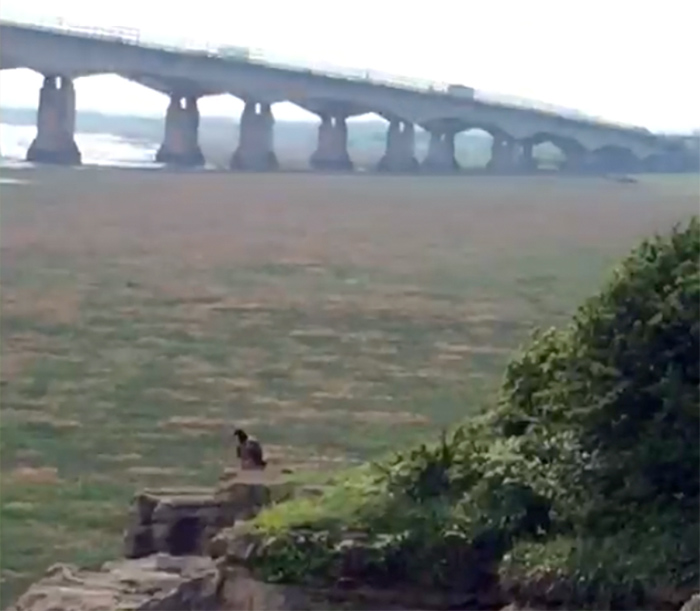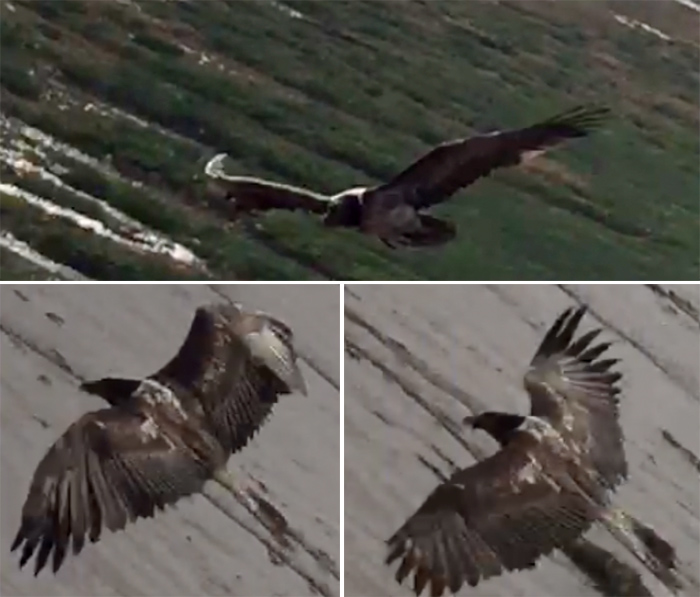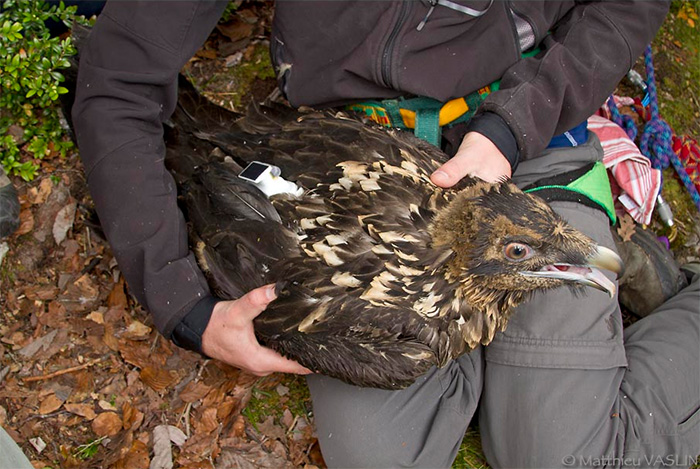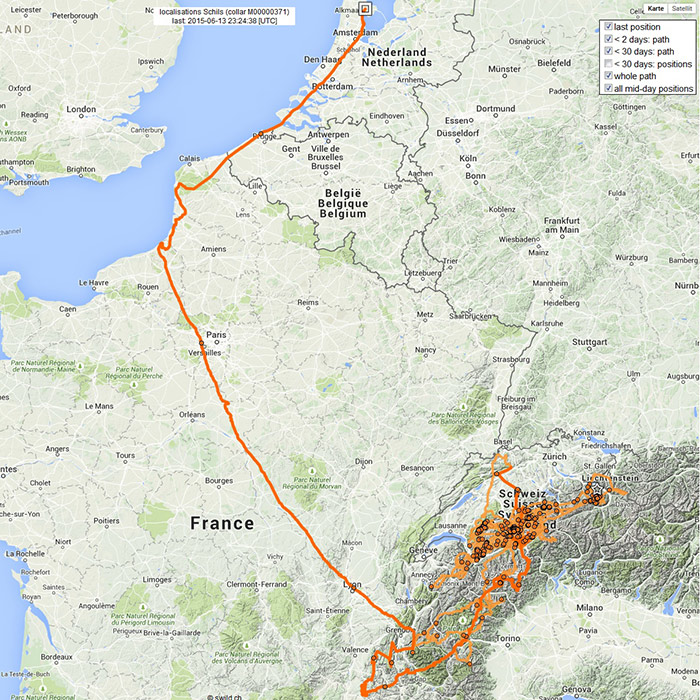Bearded Vulture - a Dutch perspective

As a Dutch birder and twitcher who saw a Bearded Vulture in Netherlands in 2015, I put a lot effort into finding out whether this bird would be wild or not, where it would have come from and, in the end, would it be a bird I could get onto the Dutch list. Because this issue also is relevant to UK Birders, I shared the collected info below.
I believe that UK Bearded Vulture is a wild-born bird and I shall now give the reasons for coming to this conclusion.
Captive Origin?
Most Bearded Vultures in captivity belong to the breeding program and none of these birds have escaped, so an escapee from this source can be ruled out.

Why wild?
- No clear markings on the wings or tail (rings might be really difficult to see, so I don't rely on that). All reintroduced birds are fitted with bleached feathers, which are lacking on the UK bird.
- All the released birds have been fitted with a GPS-transmitter. None of these birds travelled to the UK. (below is a map of a GPS-track of a bird that was found weakened in the Netherlands last year, as an example (source: VCF, International Bearded Vulture Monitoring (IBM) and Stiftung ProBartgeier). This bird was not seen, although it flew over Paris, Rotterdam and the Dutch main migration counting station Breskens. Based on that data: it flew at altitudes of 300-700meters. So...really difficult to see, even for a big bird like a Bearded Vulture.
- It is always possible that the GPS transmitter could be lost and the bleached feathers could have moulted. Therefore it is important to determine the age of the bird. This bird is definitely a 2nd CY. At this age, the bleached feathers should be still visible. Bearded Vulture moult their feathers in a really specific way and order. So, when it is a reintroduced bird, there feathers (or some of them) should be still visible. Even if it is a 3rd CY, that would be the case. 4th CY would be difficult, but based on the plumage it's not a bird that is that old. To be sure about this, we have to get better shots. Then we can determine the age and check the colour patterns that were used in the reintroduction programs in the bird's year of birth.
Where does the UK bird come from?
I'm afraid that's impossible to tell at the moment. If a feather could be obtained then genetic analysis by the VCF, can determine where it came from.
Bearded Vulture reintroduction in Europe
The Bearded Vulture became extinct in all the European mountains except the Pyrenees. In 1913 the last bird in the Alps was shot, the birds in the Balkans have gone since around 2000. So populations are still on Crete, Corsica and the Pyrenees.
Re-introduction, managed by the Vulture Conservation Foundation, started in 1986 in the Alps (Austria) and since 2006 in Andalucía. Restocking the Corsican population has been done for the first time this year. All the birds that are released belong to the European Breeding Program managed by the VCF. They use ONLY specimens from the barbatus subspecies, all from Eurasian background (so the fable of meridionalis blood in the reintroduction birds is totally false).

Since the release in Andalucía in 2006, a pair raised 1 youngster in 2015. Since the release in the Alps, around 150 young (128 until 2014 and 21 in 2015, but provisional data) were born in the wild (source: VCF and International Bearded Vulture Monitoring), the first in 1997 in France. In total there are around 215 breeding pairs in Europe, with the majority in the Pyrenees (source: VCF and International Bearded Vulture Monitoring). Because the adults start laying eggs in their 5th-7th year, it would be possible to find 3rd generation wild-born birds from the Alps by now.
Populations now occur in the Pyrenees, Alps, Andalucía, Corsica, Crete, Turkey, Morocco (and more east into Asia off course).
Vagrancy Potential of Bearded Vulture
The vagrancy potential of the Bearded Vulture is pretty impressive. We have found observations of vultures during the period that they were extinct in the Alps (1913-1986), so they came from either the Pyrenees, Balkans or Corsica (or even further). At least 16 observations in the Alps were found in literature.
Also until 2006 (when reintroduction started in Andalucia) at least 7 observations were found in literature of birds flying far west of the Pyrenees. Also observations were found on Jbel Moussa in Morocco, the peak where the main migration to Tarifa and Gibraltar starts. Between 1980 and 2014 12 observations were made in Sardinia, where none occur. They probably originated from Corsica.
When looking at Bearded Vulture on a genetic scale, the vagrancy of the species can be seen. When analysed, there are 2 clades to be found (1 of western Europe and 1 of Russia and further east). Both clades have developed separately. These clades have a geographical dispersion, but both clades exist together since the end of the last Ice Age.. The mixture of those clades is ideal in the old Alpine population (50-50). So the gene-flow from this dispersion can still be found today.

In more recent years, with lots of observers and availability of GPS-loggers, the dispersion of Bearded Vulture is recorded much better. At least 11 reintroduced birds were seen outside the Alps since the start of the reintroduction (France, Belgium, the Netherlands, Germany, Denmark, Norway). Around 8 wild-born birds were seen and then there are about 15 of unknown origin.
Some people state that the dispersal of Bearded Vulture is not natural, but is an effect of the reintroduction and they point at the Pyrenees to prove that position, stating that research there has proven that they never get out of the mountains. Margalida et al, did a lot of research regarding this subject. Conclusion in the research is that the birds they used for the research were to old (Beaded Vulture disperse a lot in their 1 and 2nd CY and then they move around ever less when they get older), the supplementary feeding stations in the Pyrenees might keep the birds inside the mountains (there are no such stations in the Alps), the genetic fitness of the population (genetic erosion) might have an effect of dispersal. So the behaviour of the Pyrenean birds might be unnatural instead of the other way around.
The last wild-born Bearded Vulture in the Netherlands was seen in 2015. Because of the info above (and some more), the Dutch Rarities Committee decided to re-evaluate its status.
Previously all records were rejected because they were thought to be reintroduced birds. Now, the status in under review and the 'verdict' is expected any moment. As a twitcher (and one of 30 to have seen the bird) I highly await this verdict. Off course, I am very confident to a good outcome!
Request to UK birders
If the UK bird is found weakened or injured it is imperative that it receives specialist care and treatment. Some veterinary drugs and antibiotics can cause this species great harm. If any UK birders see the bird in need of attention please contact Rare Bird Alert immediately who will make contact with me to arrange for appropriate care, thank you.
Hans Pohlmann
Netherlands
17 May 2016
Support the Vulture Conservation Foundation
The Vulture Conservation Foundation is committed to conservation, restoration and protection of vultures as umbrella species for their natural habitats throughout Europe.
You can find out more about their important work and donate to their projects at http://www.4vultures.org/







